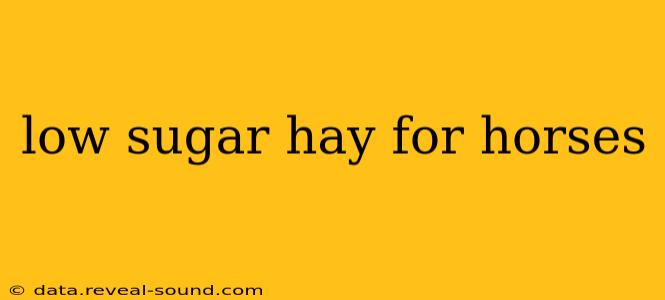Finding the right hay for your horse is crucial for maintaining their health and well-being. For horses prone to conditions like insulin resistance, Cushing's disease, or equine metabolic syndrome (EMS), choosing low-sugar hay is paramount. This guide explores the importance of low-sugar hay, how to identify it, and what options are available.
What Makes Hay High or Low in Sugar?
The sugar content in hay is influenced by several factors, primarily the plant's maturity at the time of harvest. Younger grasses contain more rapidly digestible carbohydrates (sugars and starches), while more mature grasses have a higher proportion of less digestible fiber. The type of grass also plays a significant role; some varieties naturally have higher sugar content than others. Weather conditions during growth and storage also impact sugar levels.
Key Sugars in Hay: The primary sugars of concern in equine nutrition are water-soluble carbohydrates (WSC), which encompass fructans (fructose polymers) and glucose and sucrose. These are quickly absorbed into the bloodstream, potentially causing problems in susceptible horses.
How to Identify Low-Sugar Hay?
Identifying low-sugar hay requires diligent testing and sourcing. Relying solely on visual inspection is insufficient. Here's how to determine if your hay is suitable:
-
Hay Analysis: This is the gold standard. A reputable lab can analyze your hay for WSC, starch, and other nutrients. This provides precise figures to guide your feeding decisions. Ask your veterinarian for recommendations on accredited laboratories in your area.
-
Hay Source: Work with reputable hay suppliers who are knowledgeable and transparent about their harvesting practices. They should be able to provide information on the type of grass, maturity at harvest, and storage methods. Inquire about their testing procedures.
-
Visual Inspection (Limited Use): While not definitive, visually inspecting the hay can provide some clues. Look for hay that is mature, with a slightly coarser stem and a less leafy appearance compared to young, lush hay. However, appearance alone cannot guarantee low sugar content.
What Types of Hay are Typically Lower in Sugar?
Certain types of hay tend to have lower sugar levels than others, but always test your specific hay to be certain. These include:
- Mature Timothy Hay: Timothy hay harvested at a later stage of maturity generally has lower sugar content.
- Mature Orchard Grass Hay: Similar to Timothy, mature orchard grass can be a suitable option.
- Grass Hay (Specific Varieties): Certain varieties of grasses are naturally lower in sugar, but this can vary depending on growing conditions and harvest time. Your local agricultural extension office might be able to recommend low-sugar varieties grown in your region.
What are the Risks of Feeding High-Sugar Hay?
Feeding high-sugar hay to horses with metabolic disorders can lead to several health problems, including:
- Insulin Resistance: Increased blood sugar levels can overwhelm the horse's insulin response, leading to weight gain, laminitis (inflammation of the laminae in the hoof), and other metabolic issues.
- Laminitis: This painful condition can result in lameness and potentially hoof loss. High sugar intake is a significant risk factor.
- Equine Metabolic Syndrome (EMS): A group of metabolic abnormalities that increase the risk of laminitis and other health issues. Managing sugar intake is crucial for EMS management.
- Cushing's Disease: Horses with Cushing's disease often have difficulty regulating their blood sugar.
How to Transition to Low Sugar Hay
Sudden changes in diet can upset a horse's digestive system. Gradually introduce the low-sugar hay over 7-10 days, mixing it with the previous hay. Monitor your horse closely for any digestive upsets during this transition period.
Other Considerations for Horses on Low-Sugar Diets
- Hay Testing Frequency: Regularly testing your hay is recommended, particularly if you're dealing with a horse with metabolic conditions.
- Supplements: Your veterinarian may recommend specific supplements to support your horse's metabolic health.
- Exercise: Regular exercise helps to regulate blood sugar levels.
- Veterinary Guidance: Always consult with your veterinarian for individualized dietary recommendations for your horse.
By carefully selecting and managing your horse's hay, you play a vital role in promoting their overall health and longevity. Remember that consistent testing, responsible sourcing, and veterinary consultation are key components of providing optimal equine nutrition.
